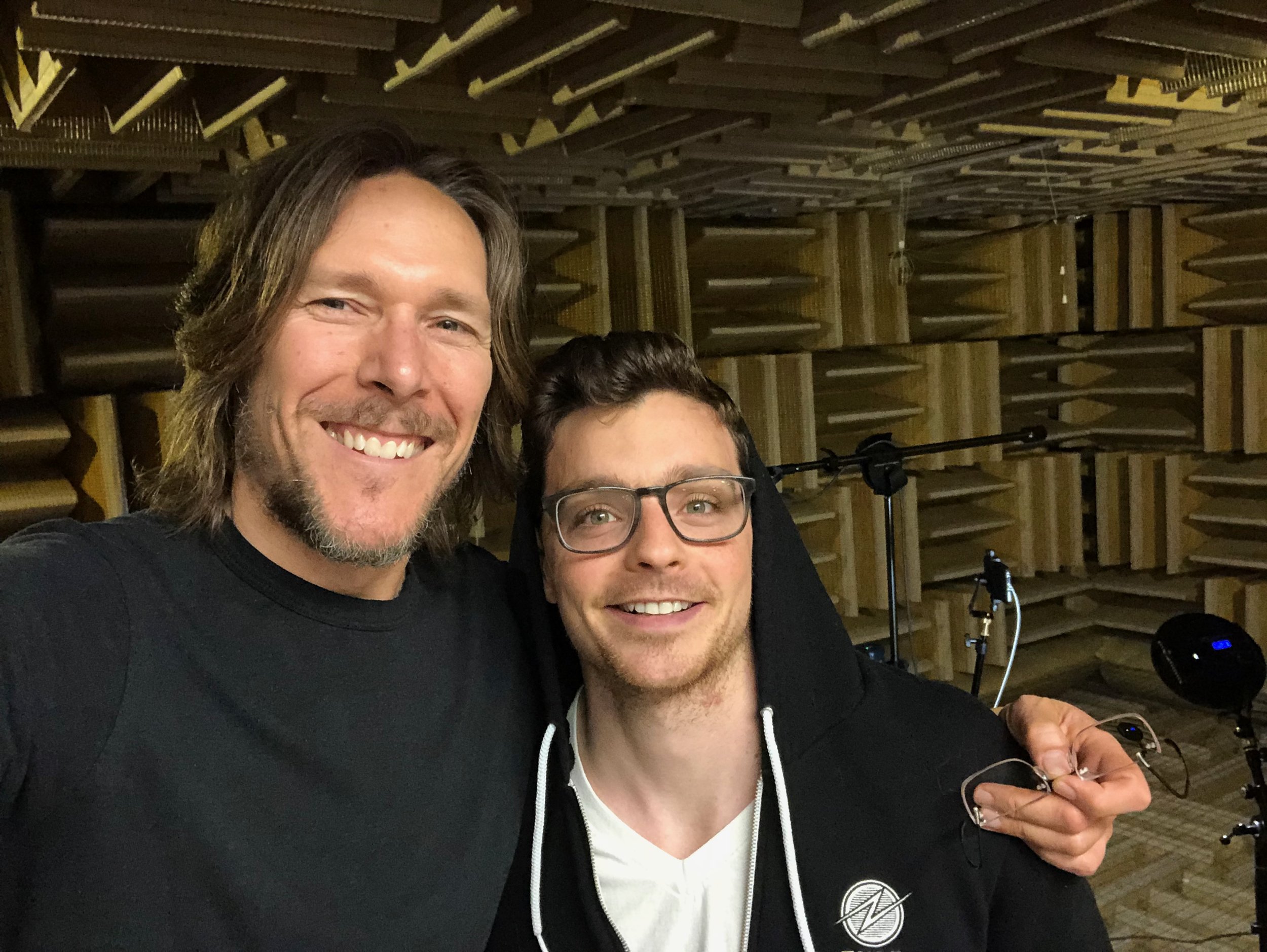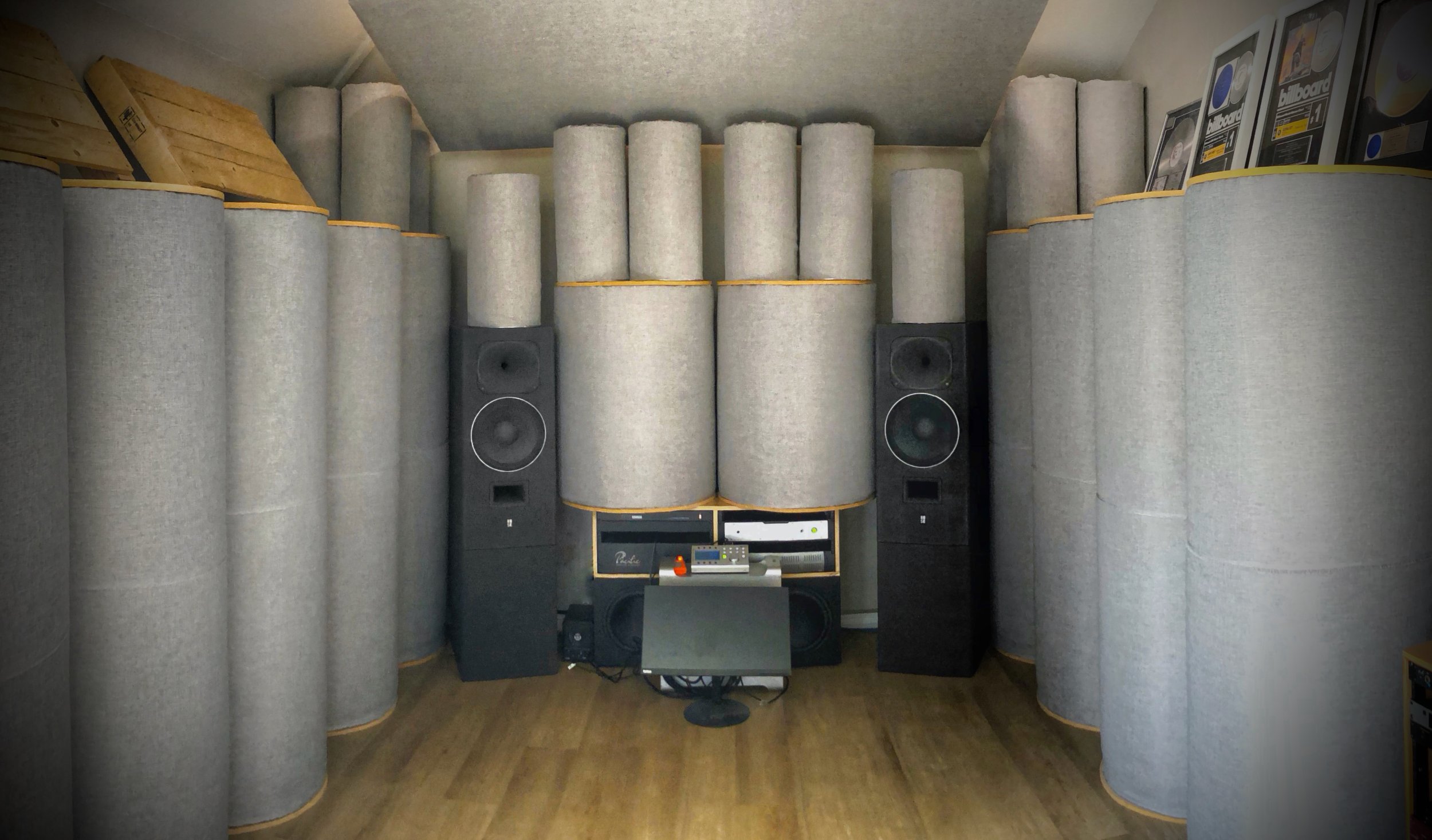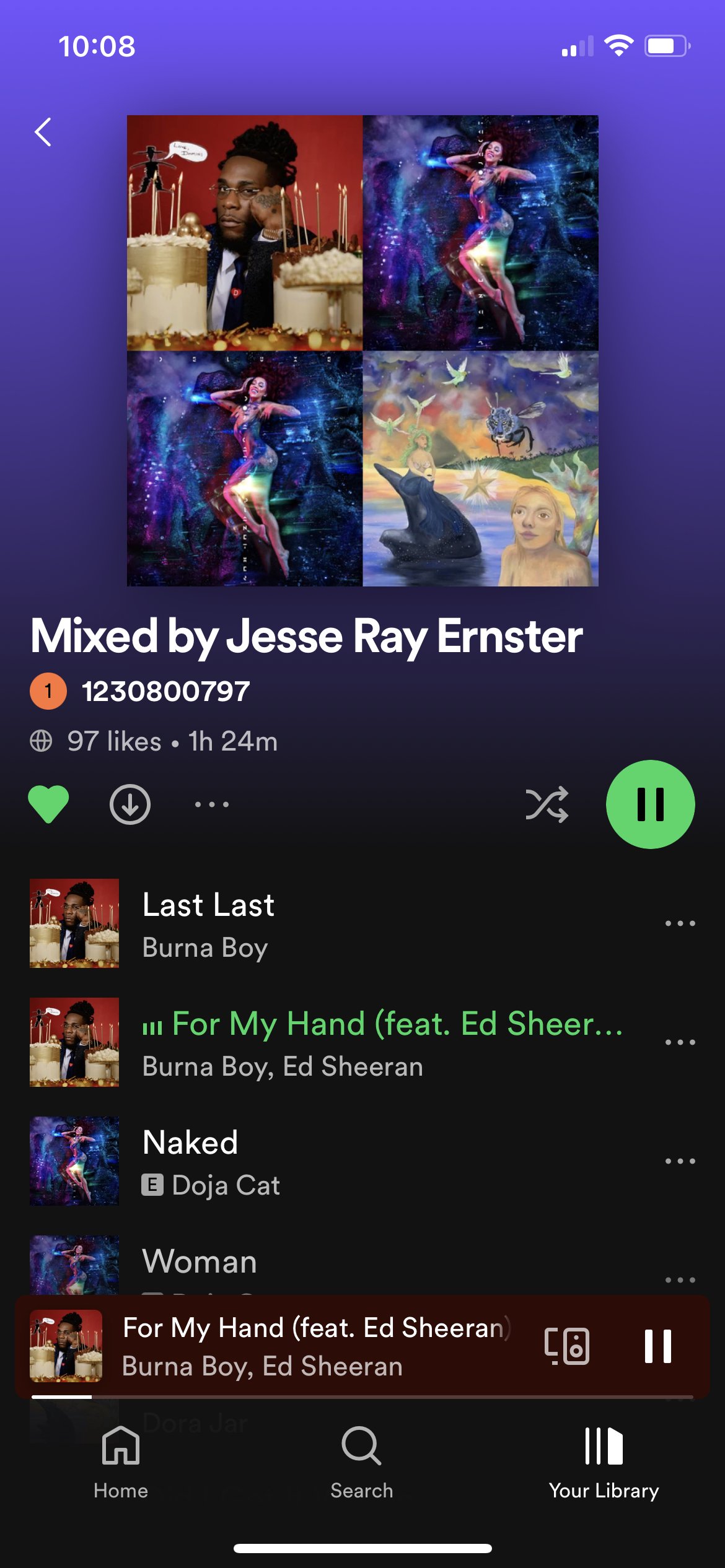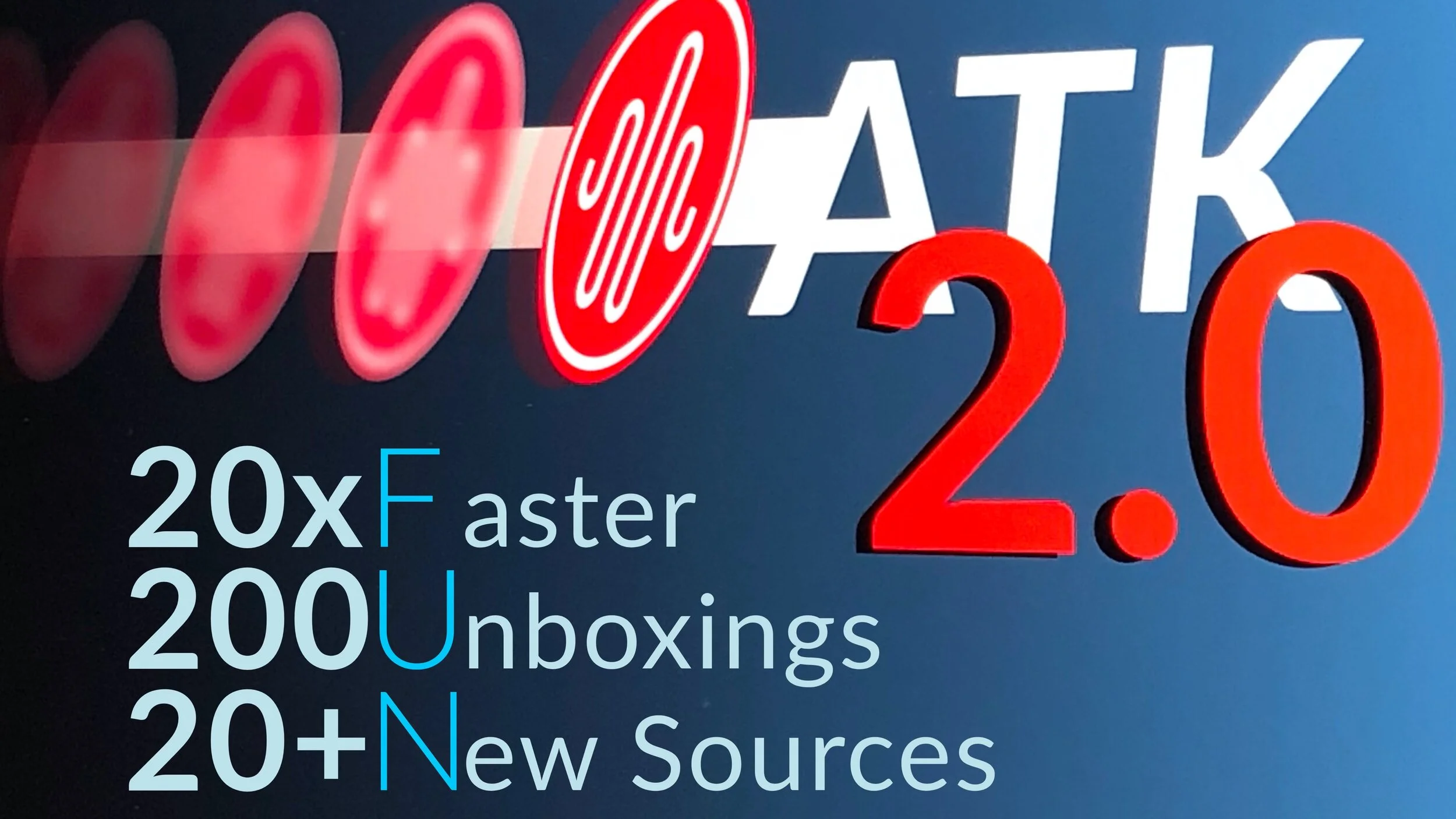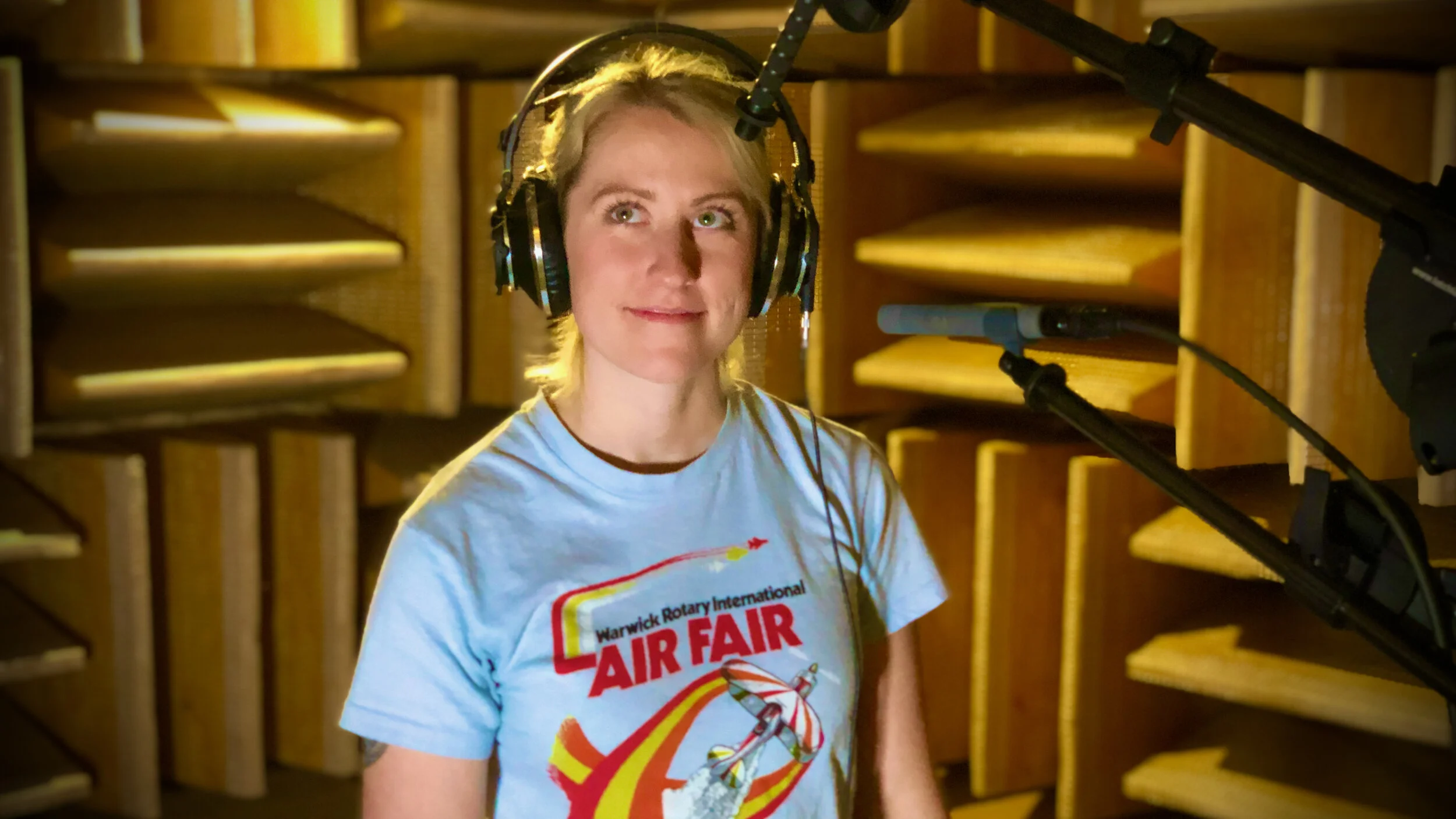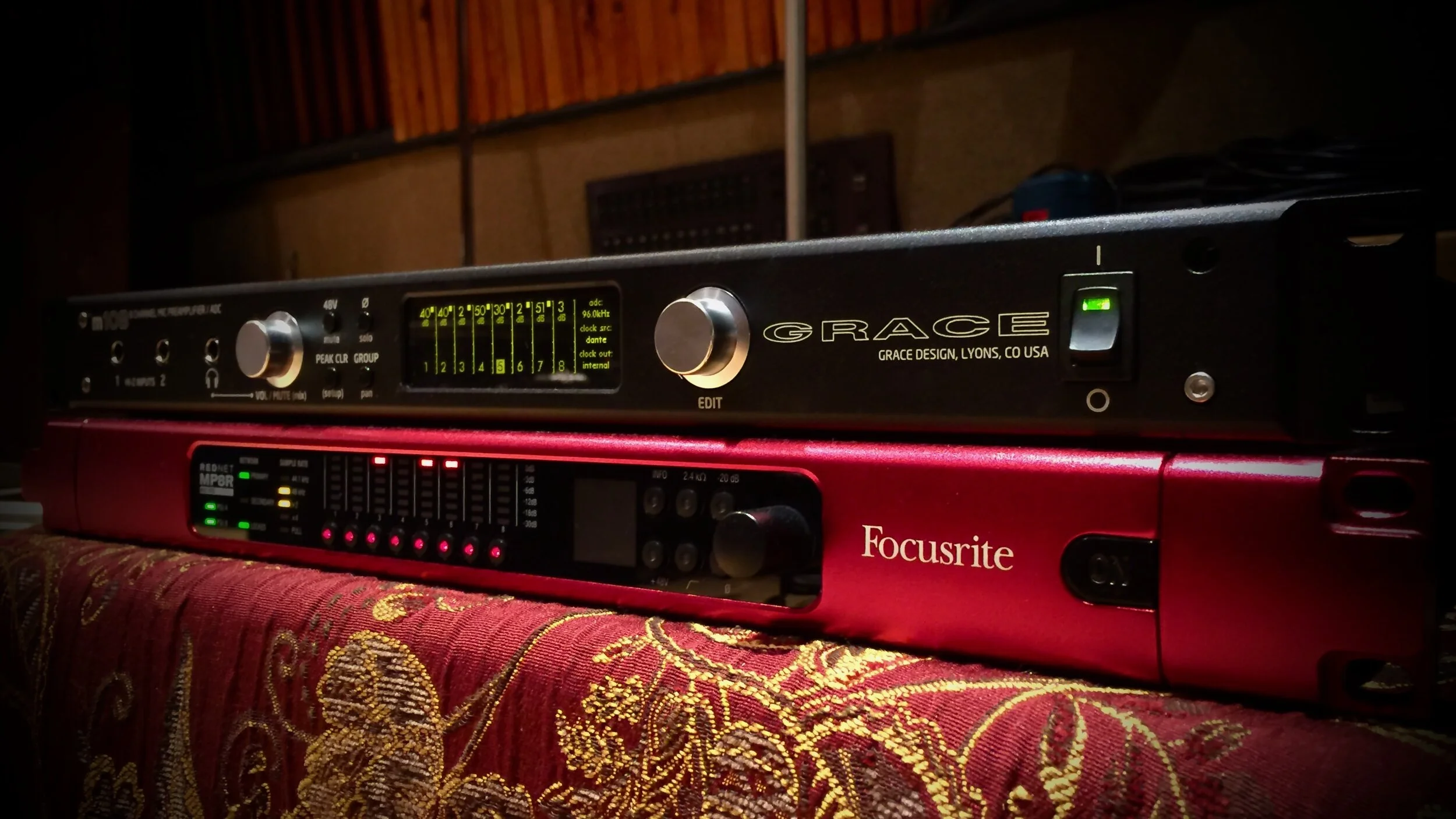A Grammy-Winning Engineer's Guide to Choosing Studio Monitors
Jesse Ray Ernster in one of his famous ‘deskless’ studios powered by the Strauss Elektroakustik SE-MF-4
by Alex Oana
Culver City, California
Jesse Ray Ernster is my buddy. The first time we had coffee in 2017 when he moved from Minnesota to California, like I had 13 years prior, we discovered he had just played guitar at my college reunion. I was lucky that along with James “Fluff” Harley (Prince, Korn) Jesse Ray lent his creativity and bat-like hearing to develop and record Audio Test Kitchen’s massive microphone library. This is a guy who leads with his heart above all else. Because Jesse Ray has a way of acknowledging and elevating the greatness of whomever he’s with, it’s no surprise that his recent collaborations earned him a Grammy for mixing Burna Boy’s gorgeous sounding “Twice as Tall” record and three Grammy nominations for mixing Doja Cat and Kanye.
I don’t say this lightly: I love Jesse Ray’s ears. His instincts are for lushness, dimension, depth, and punch, never with any harshness – the kind of chewy mixes that sound great at any volume.
What started the other day with Jesse Ray as one of our typical text exchanges, turned into a deep dive into navigating studio monitor choice. With these four words, “May I quote you?” we turned it into a blog to share with you. Here’s the transcript of our iMessage thread exactly as we typed it minus only the most embarrassing bits.
Alex Oana:
What’s mysterious and frustrating to you about choosing studio monitors? What guidance and insights would be helpful?
Jesse Ray Ernster:
Pondering this. Back shortly with thoughts
Alex Oana:
Any big picture thoughts?
Jesse Ray Ernster:
OKAY! Sorry for the delay here.
It’s incredibly challenging to assess a work tool’s usefulness at reproducing sounds to inform decision making in the music-making process. It’s a lengthy study of translation, comparisons, and client feedback. Yet, consumers are expected to sit down in a showroom and be “WOWED” into making an enormous purchase decision right there on the spot, simply based on the sound they’re hearing, rather than how that sound will, in effect, inspire decisions/moves to be made (A sparkly listenable speaker isn’t always the tool that pulls greatness out of the creator).
Not to mention the over-saturated marketplace full of bold claims of “low distortion” and “flat response”.
I learned to avoid marketing and forums, and instead place a higher focus on the opinion of people whose work I admire and relate to.. deeply. If XYZ superhero mixer seems to hear music the same way I do, has a similar workflow, similar translation endgoals, similar genre, works at a similar pace/number of hours per day, etc, then this is a good starting point for finding advice on something that could work for me.
Those are the only thoughts I have right now!
Alex Oana:
May I quote you?
An innocent beginning over text evolved into a revealing discussion about how to find studio monitors.
Jesse Ray Ernster:
That was a big blurt/throwing paint at the canvas.. probs needs revising
Alex Oana:
Nope. Those are the BEST
Spontaneous direct honest
Jesse Ray Ernster:
Hell yeah.
Alex Oana:
Would a text exchange be a good way to do our studio monitors dialogue?
I like the idea of a back n forth.
Jesse Ray Ernster:
Yes let’s catch up in a lil bit?
Alex Oana:
Good morning, buddy. I’m going to kick off our dialogue with a reminder of the brilliant way you encapsulated your perspective above on the topic of ‘choosing monitors.’
Alex Oana:
Why do you think there are so many studio monitors in the market?
And don’t worry about having to reply with big long complete answers. We can have this dialogue any way we want.
Jesse Ray Ernster:
been a DAY
Alex Oana:
Oh yah, no worries. Take the pressure off my man. Keep it fun! Irreverent. Searingly honest
Jesse Ray Ernster:
Well, it’s a beautiful thing really.. In this modern era, so many passionate individuals have the opportunity to bring their loudspeaker and product visions to life. Designers, audiophiles, and geeks alike that all “caught the (audio) bug”, are able to develop and share their tinkerings with the world. The main downside to this is the immense difficulty it brings to the decision making process; the market is completely over-saturated with different monitoring choices and it’s tough to even know where to begin!
i’ll get less rigid as we go btw; Feel free to paraphrase and dumb it down
Alex Oana:
You can frame your thoughts how ever you want.
Jesse Ray Ernster:
Cool
Going to do talk to text to help the dialogue feel natural
Alex Oana:
Natural Jesse Ray. My favorite
Jesse Ray Ernster:
This interview has taken a very exciting turn. I think the readers are really in for a spicy surprise.
Sometimes the good guys win.
Alex Oana:
So why are these audio designers compelled to keep trying to solve the same problem over and over in a different way?
Jesse Ray Ernster:
Off the record, this is a humongous question, and I don’t really know how to answer it to be honest…
Well, it’s the wild west. The variables (user application, design philosophy, budget/limitations, components, etc) are seemingly endless, as there are so many different ways to get a driver to produce sound, and every manufacturer seems to have a different way of going about it. For some of the artisanal manufacturers, there’s a “thrill of the chase” aspect to the journey of developing an amazing product, and for some of the bigger corporations, I’m sure that there’s more of a capitalistic-leaning approach to developing more of a limited product as a means to expand their product line. It’s the marketing, misinformation, and testimonials that really begin to confuse things… lol
Alex Oana:
Studio monitoring is light years from where it started 100 years ago and in the last 10 years it seems like even the most affordable products have gotten pretty good, in no small way due to a lot of ‘idea borrowing.’ Yet you and I wouldn’t be having this conversation if there were such thing as “The Perfect Studio Monitor.”
If the perfect monitor did exist, what would it be like?
Just non-stop bliss
Jesse Ray Ernster:
Well, the ideal monitor for me, would be one that perfectly represents what the listeners will hear. So in a way, we already have that in the form of airpods; one universal playback system that sort of levels the playing field and eliminates a lot of the guess-work. But the non-headphone playback systems are still a wildcard unfortunately.. I guess the dream monitor would feel as lifelike and captivating as imaginable, as if the performance was happening right there in the room
Alex Oana:
Ha, two awesome threads here.
WHAT THE LISTENER HEARS
That’s it, right? If we could only dial it in for exactly what the listener will hear, what’ they’re listening on. The AirPods and the OG EarPods are probably the most ubiquitous. Do you reference on both? What do you learn about your mixes when you do?
I think the biggest advances for consumer listening are happening with automatic compensation. The AirPod Pro 2 listens to the sound after it bounces around your ear canal and automatically tweaks the EQ. My Sonos Move speakers listen to the room and automatically sculpt the low mids and bass to compensate for what the mic array is learning about the room. And I think it sounds great. I always like it better for recreational listening.
So maybe we’re getting closer to a world in which at least the playback system’s EQ is closer to some kind of standard.
THE DREAM MONITOR
I totally get what you’re saying - the perfect monitor would exactly reproduce whatever you put into it. Reminds me of what ATK had to do for our vocal reproducer, re-amper.
The way you phrased that reminds me of the kind of language I see in the Hi Fi world: “As life-like as the live performance.” That claim would only be true or possible if the recording attempted to and was capable of perfectly capturing the live performance.
But of course that’s not at all how most recordings are made - they’re produced to sound larger than life. And most modern mixing inherently mangles and massages and enhances the performances.
So, in the context of what you do as a pop music (broadly speaking) mixer, is it fair to say, the perfect monitor sounds indistinguishable from a perfect DtoA conversion of what’s coming out of your DAW?
It’s possible wherever Jesse Ray goes, he is in his happy place
Jesse Ray Ernster:
I’m back!
Alex Oana:
yay
Jesse Ray Ernster:
I only check on AirPods now, as I don’t feel that the older wired earbuds have much of a listener-base anymore. I mainly listen for two things: to make sure that the low end translates to the slightly tubby resonant nature of the AirPods, and I’m also checking for how the center channel information is summing and translating to headphones; the way that left and right sums into the center channel hits me very differently when comparing between a mix on loudspeakers and headphones, so it’s important to check to ensure that the vocal isn’t too far forward in the headphone mix, for example.
You’re so right about how that technology is improving the listening experience. I am a purist in some regards, however I am fully on board with dsp correction and compensation to level the playing field
Yes, the world would be a much better place if everyone heard music exactly the way it sounds coming out of my speakers in my room. Hearing the dimension of the soundstage with such a profound level of detail and believability, is something that most humans just simply haven’t had the privilege of experiencing.
But yes, the goal is to get the information to translate to the listener, no matter what playback system they are listening on; I think a lot of the fun comes from that challenge! So many of the great engineers are masters of the balancing act: they are able to produce high fidelity recordings that boast thick harmonic density that sounds incredible, strong, and clear on the extended-range high fidelity systems as well as on the smaller, more resonant and compromised playback systems.
Alex Oana:
You just mentioned the phenomenon of resonance twice in the context of compromised listening. Tell me more about that.
You can skip that request if you like.
Let’s do this question instead:
Tell me more about the sound coming out of the speakers in your room. Can you describe it? And what monitors are you using?
Jesse Ray Ernster:
No, the first question was great
Alex Oana:
Okee. We’ll get to the 2nd one in a bit.
Jesse Ray Ernster:
Well, many people express a great concern with finding monitors that are “flat” in response, but the resonance and overall decay time (and how it varies across the spectrum) is way more detrimental in my opinion. How can you accurately dial-in the bounce and snap of a snare drum if the actual enclosure of the speaker is ringing out and sustaining the fundamental pitch of the snare in the lower frequencies? The unfortunate result of that scenario is overcompensating for the lies that you are being told from a poorly-designed monitoring setup. Then, in an attempt to choke and tighten the lower end of the drum mix, the resulting sound will simply not translate properly on other systems
Alex Oana:
Oh, that’s such a great point. I know for sure I’ve dialed in kick drum sounds on particular monitors only to learn when referencing on other speakers that my carving and crafting were mostly just optimizing some characteristic exclusively inherent to that pair of speakers.
There’s a cool visualization of what you’re describing that shows decay over time across the spectrum. I’ll include an example pic in this article.
The Cumulative Spectral Decay, more commonly known as a waterfall plot, shows a series of frequency responses of the loudspeaker that are taken later and later in time as one moves from the back of the plot to the front. It is used to visualize resonances. The response at the back is the frequency response shown in the first graph above. It is typical that bass takes longer to decay, hence the decaying ridge is seen near the bottom end of the loudspeaker response. Ported loudspeakers have longer decays than sealed designs, and loudspeakers with a deeper bass response also have longer decays. Other resonances should be very short in comparison and ideally not present at all. — Courtesy ADAM Audio
You said you wished listeners could hear what’s coming out of the speakers in your room, “the dimension of the soundstage with such a profound level of detail and believability.” What monitors are you using?
You’re in Plugin Alliance now? Is that awesome? That seems awesome. Congrats!
Jesse Ray Ernster:
Tanks man!
Currently in San Diego with the fam.
Alex Oana:
Ah ha! San Diego for Easter sounds great.
Jesse Ray Ernster:
I’m using the Strauss MF-4 monitors. They’re passive 2-way midfields with inconceivably detailed micro-dynamics
Alex Oana:
Wow. So much to chew on here. We’ll bite this off in chunks.
From what I know, Strauss Elektroakustik is relatively new on the studio monitor scene. I’ve only seen you, Eric Valentine, and Kim Rosen with these monitors. What was your journey like to find these?
Jesse Ray Ernster:
I found out about these through Eric’s recommendation actually! Ordinarily I am very guarded when it comes to product recommendations and (especially) artist testimonials, but I felt that Eric heard music in a similar way that I do, with a similar aesthetic, and that we ultimately shared similar translation goals. He spoke about having a lifelong love-hate relationship with the ns10’s, and I could definitely relate; after growing so accustomed to those flawed little boxes, it was tough to find a monitor that would produce similar results, despite the major drawback being the pain and harshness throughout the production/mixing process. He said that these were the solution! So I tried out the Strauss nearfields, the NF-3’s, and loved them instantly. They had that 2-way passive speaker magic.. punchy, warm, with extremely low distortion and very active transient information.. finally a speaker that gave useful information and was easy to use without the unfortunate translation surprises later on. I eventually moved up to the bigger models, but they’re all voiced super similarly.
Eric Valentine brought his Strauss SE-NF-3 monitors with him to RCA Studio A in Nashville to make the latest Nickel Creek record.
Eric Valentine just installing his Strauss SE-MF-4 in his new control room.
"It feels incredible in this room. The speakers sound unreal. Like absolutely unbelievable. It's so cool to hear the Strauss (SE-MF-4) monitors in a room that's really treated properly. They are just unbelievable sounding. I'm so pleased with the sound... Absolutely by far the best monitoring I've ever had, I've ever heard in any control room I've ever been in. It's like, yeah. I'm just like giddy." — Eric Valentine
Alex Oana:
Hey buddy! It’s NAMM week! See you tonight at Apogee?
Three questions:
How would you sum up what it is about NS-10s that you love and were looking for that lead you to the Strauss NF-3s?
Is there something about passive speakers that’s different to your ears vs. active?
And what do you mean about “micro dynamics?”
Jesse Ray Ernster:
Yessir see you tonight! I’ll be there around 8
Yes, to me, the NS10’s have a remarkable way of revealing imbalances and overlap, especially in the midrange. They aren’t necessarily fun or impressive to listen to, but they provoke a deeper level of decision-making from the engineer, and it inspires for deeper digging into the mix. NS10’s and their whacky little paper cones make it a breeze to sift through a dense arrangement when EQ’ing vocals, guitars, and keys/synth instruments to fit together in the mix. This is obviously just based on my experience and opinion, but I firmly believe that a monitor has to be worked on for a long period of time (months) in order for a user to truly measure the tool’s effectiveness. I find it incredibly challenging to assess a work tool’s usefulness at reproducing sounds to inform decision making in the music-making process. It’s a lengthy study of translation, comparisons, and client feedback. Yet, consumers are somehow expected to sit down in a showroom and be “WOWED” by the sound of a mastered reference mix, and then they’re coerced into making an enormous purchase decision right there on the spot, simply based on the sound they’re hearing, rather than how that sound will, in effect, inspire decisions/moves to be made. A sparkly and highly-listenable speaker isn’t always the tool that pulls greatness out of the creator.
One of the areas where the ns10’s really fall short is the micro-dynamics; they distort the transient info pretty heavily and the result is a very untruthful representation of the dynamic content when it comes to accurately conveying level/attenuation changes and gain reduction. A mix may sound clean and punchy with the engineer fully-believing that the compression is perfectly dialed in when monitoring on a distorted speaker like the ns10’s, but when switching over to something high fidelity like the big Strauss midfields, it’s immediately obvious that the mix is pumping, distorted, and completely messed up! (Haha!)
I can’t attest to any differences in the sound of active versus passive, but I simply like to keep the amp and speaker separate. I had a bad experience when one of my Adam A7x’s burnt out, and the only option was to ship overseas to Germany to have it repaired, which was going to be costly and time-consuming. Instead I found a set of ns10’s for $90 and a free AV Receiver to power them. I was off to the races!
This is going to be a fun article 😊
Kim Rosen’s Strauss SE-MF-4 monitors in her Knack Mastering studio.
Alex Oana:
Oh man. You are talking my language. It is quite a special and rare experience when a speaker or headphone reveals distortion, bad limiting, and crunchy dynamics that typically go undetected as such. I want to give the engineers who bake in these negative artifacts the benefit of the doubt and believe that they meant for it to be there. But for my taste, it makes the music unlistenable. It’s not just taste, it’s a physical reaction for me.
The way that kind of artifact shows up on Apple AirPods where I so often listen is harshness that prevents me from being able to turn up the volume or listen very long. There’s something about the Bluetooth codec that is intolerant of these artifacts. So sad that a great deal of content has been rendered broken.
I’ve reached out to you a few times and said something like, “Man, this record sounds unbelievable but somebody just pushed it 2dB too far." All that amazing work covered by a mask of pain.
As I think about this, would you agree that what we’re suggesting here is that it’s quite likely engineers who are creating material like this aren’t hearing what’s really there. Their intention is to create more energy and excitement, but their monitoring isn’t revealing the other side of that coin. Or maybe they know they’re doing it, but Rick Ruben or some A&R is forcing their hand.
What I notice about your work is a lushness and fulness without that kind of harshness, and with no compromise in level and excitement. It seems to me the results you get are not only due to your listening, skills, and creativity, but your insistence on hearing the truth of what’s really there in your work.
Perhaps if we all heard more clearly we would seek other/better ways to achieve the excitement without the downside.
Jesse Ray Ernster:
Off the record
MAN SO MUCH JUICY STUFF TO RAP ON HERE!
Alex Oana:
F yes. Rap on brother. No fear.
Jesse Ray Ernster:
Hi! Let's pick this back up! But also, I want to jump on a call with you to pick your brain on a couple of unrelated things
Alex Oana:
Can I call in a few?
Jesse Ray Ernster:
I’m on other calls
How’s tomorrow am?
Alex Oana:
JR, we both just said a mouthful. Do you want to pick a morsel from the four course meal to dig into?
I think we’re about 2/3 or 3/4 done with our monitor discussion. Let’s bring it home so I can publish it this month.
Jesse Ray Ernster:
Yesssss
Absolutely. How do we, as engineers, ride that fine line of injecting energy and excitement into a recording without losing the bounce and the integrity of the transient information!
It’s funny you mention the AirPods’ inability to handle those artifacts, because I personally feel that they actually mask dynamic pumping and distortion quite deceptively (those sneaky devils)! I’ve made the mistake of approving final masters over AirPods in the past, only to be met with utter disappointment when I heard them on the “big rig” later on and all of the flaws were revealed.. too late! Gotta live with it (sigh) lol
Alex Oana:
I think the AirPods artifact thing is a result of bad clipping. I should do a better analysis of what’s going on next time I hear it.
I have another thought on the process of choosing studio monitors: Isn’t it true that high quality tools can actually be teachers? If that’s true, what’s happened to your listening ability and hearing ability when you’ve upgraded your listening tools?
Jesse Ray Ernster:
Ah, yes! Well, I’ve leveled up in two major ways thanks to my monitors: panning and balancing! Learning to place things around in the stereo field with panning is so fun and crucial when you can finally hear a system that’s firing perfectly in phase. It’s like you can close your eyes and just envision the sonic landscape in front of you (and around you), and it has really helped me paint better musical pictures! I’ve also noticed a profound increase in my sensitivity to level changes, both in and out of the studio, simply because of how meticulous my environment is; I suppose the monitors are just conditioning me slowly to hear these 0.1db dips/spikes in volume. Definitely helps for placing balances as well as evening out vocal performances!
Alex Oana:
Ah ha! You said, “environment,” not monitors. You’re talking about the whole system: DtoA from DAW > monitor controller > monitors+amps > room. Just for a second, let’s isolate the monitors portion of that system. Now that you know what a great monitoring system sounds like, talk about just the monitors aspect of that, what you need that component to do.
Jesse Ray Ernster:
The monitors should play back an artist’s recording while imposing as little color as scientifically possible. The first impression that I get during the initial 1-2 times I hear a song before I begin mixing is integral; I make blanket observations about the overall tonality and intention of the artist. I need to be able to hear unadulterated, unfiltered playback of exactly what the artist captured, and then I can sprint for it and trust my instincts blindly (boost top end here, cut the mids there, etc) without any hesitation or doubt in the decisions I’m making.
Alex Oana:
That sounds like a blast! To be able to remove any translation layer from your creative process and just go!
Jesse Ray Ernster:
It is!
Jesse Ray Ernster:
Jesse Ray Ernster recording acoustic guitar in Harman’s anechoic chamber for Audio Test Kitchen.
It is!
To contrast that ideal though, there are absolutely scenarios when it’s just more fun to create, produce, write, or just jam on a distorted dishonest speaker. My Jeep stereo is a great example of this: it just smacks with a big PA-esque low end that hits me in the chest (man it must be 8db up at 50hz haha).
Alex Oana:
I love 50Hz. It may be my favorite frequency.
If you could only choose five frequencies what would they be?
Jesse Ray Ernster:
Depends on the width and slope of the filters of course, but it’d probably be 30, 100, 700, 5k, 16k !
you?
Alex Oana:
I'm going 40, 100, 630, 5k, 12k
Jesse Ray Ernster:
F*#& 12k !
Alex Oana:
Hahaha. Why down on 12k?
Jesse Ray Ernster:
Vocal stacks have an inherent issue in which the whispy tight resonant peaks around 12k rub together and build up across the mix. Makes a mess fast! Same with 8/9khz.
Alex Oana:
Spoken like a true master. I'll change my fifth frequency to 16k shelf.
So beyond entertainment value, lol, the goal of our discussion is to provide guidance for choosing studio monitors. Let's talk about how we can help people who are just starting out. In light of everything we've discussed, how would you advise that person?
Jesse Ray Ernster:
Find what works for YOU! Spend the time to develop your ears and chops, and come to terms with the fact that the gear selection process will be a lengthy journey with many stops along the way. There is no substitute for time; just dig in and latch onto whatever gets you excited to make meaningful records!
Alex Oana:
Here here! Art is about individual expression. The more we can explore, develop, and express our own voice the better contribution to the world.
Alex and Jesse Ray share a rare mid-pandemic beer.
If you were to advise someone starting out on the specifics of finding studio monitors, how would you guide them? What are the steps?
Jesse Ray Ernster:
Missed this text so sorry
Alex Oana:
No worries. Along with the above question, I’ll be interested in hearing how you think beginner, intermediate, and expert level folks should go about finding the right studio monitors. Anything you say is correct - it’s your opinion based on your experience in current industry conditions.
Jesse Ray Ernster:
I’d seek advice on which monitors to try, from individuals who have made music that you respect and admire, as opposed to empty marketing statements and showroom sales people. It’s best if you can find a way to demo a few sets of monitors in your room. You can initially evaluate their performance with a batch of reference mixes that you’re familiar with, and then you can assess your overall compatibility with the monitor over a longer period of time by checking the translation on other sources, and by comparing to your previous work. It’s a long journey, but you’ll find your monitor counterpart!
Alex Oana:
That makes sense. What would you suggest people do if they’re not connected to the person whose work they admire? Cold DM?
I think we might be nearing the end! What do you think? Any other major guidance you want to convey?
Jesse Ray Ernster:
There is this incredible Discord community online, or a lot of great information is being spread; it’s like the modern day gear space. Is it inappropriate to direct readers over to that? Is that a conflict of interest or something?
Alex Oana:
I think that would be super cool. Knowledge is power.
Jesse Ray Ernster:
Yes, I highly recommend joining the “Live With Matt Rad” Discord server. It is a terrific community of music makers, with a lot of big players in the industry that are involved and contributing info too. A lot of great information is being shared there!
I will get you some Hi-Rez photos of the studio as well.
Another shot of Jesse Ray’s previous ‘deskless’ studio featuring Strauss SE-MF-4 monitors and a whole lotta DIY tube traps.
Alex Oana:
Brilliant!
I feel like our discussion is nearly complete. The last things on my mind...
I want you to get really personal about what you would say to an up-and-coming person who is aiming for the highest career highs… Just on the subject of monitoring and listening and ear training, how does a great set of monitors relate to their goals?
And also, from your personal perspective, if you were having a private conversation with another Pro who you totally respect, about monitoring, how would that conversation go?
Jesse Ray Ernster:
Give yourself an unfair advantage. Your growth and acceleration will increase exponentially when you can actually hear what’s going on through proper monitoring. When coming up, I lost a lot of opportunities and wore clients out with seemingly-endless notes and revisions, simply because I was delivering bad mixes that weren’t translating. I was unable to fully hear what was happening because of bad monitoring. As soon as I bit the bullet when I got the Strauss SE-NF-3 monitors, the mix approvals started happening more and more, and I began to experience creative fulfillment when I was starting to achieve the sounds I had always been hearing in my head. There was no more guesswork, and I was doing way less processing as a result.
I do talk with other pro engineers quite often about the tools that they/we are using, and it’s always a very laid-back cool vibe. There is rarely any pressure or insults toward the products someone uses. It’s like “oh you like those monitors! Cool! How do ya like them?”. It’s never a one size fits all; it’s really cool to hear the incredible results my peers are getting with a broad range of different tools being used to get there.
Alex Oana:
What mixes are you most proud of from a purely sonic perspective? I’ll provide streaming links.
Jesse Ray Ernster:
Yes, I love how Ed Sheeran’s vocal turned out on this:
Alex Oana:
You mixed Ed Sheeran?
Alex Oana:
Listening now…
Alex Oana:
Well done! Ed sounds human! His voice is natural.
Jesse Ray Ernster:
Yup, took all 5 compressors off that his engineer had on. I leveled every phrase by hand, no compression. Best he has ever sounded, hands down
I love how this one turned out, although I would add more bottom to it these days:
Jesse Ray Ernster:
And I went for dangerous low end on this one; really wanted it to be an explosive bounce:
Alex Oana:
I love your Doja mixes. But I have to say, it’s even more of a treat to hear your mixes’ full dynamic range before mastering.
Jesse Ray Ernster:
You said it, not me! 🙃
Alex Oana:
😬
I just fall into your Burna mixes. They’re so lush and inviting. Ear candy.
Jesse Ray Ernster:
I do have a comment about the dynamic range of the Masters actually. But I’m busy and will have to text you in a couple hours.
On the road with babies
Alex Oana:
That’s great. Drive safe. After that last comment, we should be all done. Thanks so much!
Jesse Ray Ernster:
In general, most of the teams I work with still have a pretty strong desire for extreme loudness at the mastering stage, and oftentimes I disagree with the decision to move forward with compromised sonics just for the sake of having louder playback in the club (because at Streaming it just doesn’t really matter). But this is a service industry, and if they feel validated and confident about the release once it has the growl and the authority of a loud master, then who am I to argue with that!
Alex Oana:
Almost forgot to ask…. Do you use Apogee Symphony SE for monitoring on your Strauss? Or are you going into your Grace M905 digitally from the DAW?
Jesse Ray Ernster:
The symphony software is replacing the 1-2 dac outputs with the spidf < Grace dac outputs. Works great! I’m certain I wouldn’t hear a difference if I shot them head to head
Alex Oana:
So which box does the D-A?
Jesse Ray Ernster:
Grace. The apogee does an equally important job- 2bus insert d/a a/d !!
[END TEXT THREAD]
Thank you Jesse Ray Ernster for the open and thoughtful dialogue on choosing studio monitors. Instagram @jesseraymix
Learn about Strauss Elektroakustik.
Learn more about choosing studio monitors in Audio Test Kitchen’s guide to choosing studio monitors from a former salesperson’s perspective.









